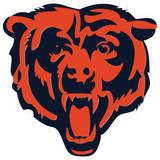
Chicago Bears: Is there Hope for Dowell Loggains?

The Chicago Bears came away with a much-needed win against the Detroit Lions on Sunday. Not only did the Bears snap a six-game losing streak against the Lions and a six-game losing streak at home, they injected hope into the fan base.
After an ugly 0-3 start in which the Bears consistently looked uncoordinated and overwhelmed offensively, Bears’ OC Dowell Loggains received harsh criticism regarding his ability as a play caller. He was called out as being predictable and unimaginative, and the Bears looked unprepared and consistently seemed to sputter on offensive drives.
Dennis Wierzbicki-USA TODAY Sports
But in last Sunday’s game against the Lions, the Bears’ offense looked coordinated and balanced, and we finally saw Dowell Loggains’ potential as a play caller.
The Bears strung together two drives that lasted over 5 minutes, each resulting in points, and three drives with more than 10 plays. They had 408 yards of total offense, two offensive red-zone touchdowns, won the time of possession battle for the first time this year (33:14 versus 26.46), and had the most first downs in a game (23) this season.
What were the keys to the Loggains-lead Bears’ attack?
Running Game Establishing Offensive Tone
It appears a Loggains’ offense needs a run game to give it balance, and RB Jordan Howard might be the perfect fit.
In Howard’s first start as an NFL running back, he led the Bears to their first 100+ yard rushing game of the season. He showed good footwork, vision, and had the patience to allow the zone-blocking scheme to develop holes for him.
Howard had an impressive 4.8 yards/carry and 111 total rushing yards. Perhaps most impressive, though, was his 68 yards after first contact.
Though this is his NFL first start, Howard’s yards after contact likely isn’t a one-hit-wonder. Howard plays with a low pad level, allowing him to gain leverage at the point of contact. After getting wrapped up, he has the ability to keep moving his feet, enabling him to fall forward. And he’s not afraid of taking or delivering big hits.
Matt Marton-USA TODAY Sports
That is exactly what the Bears need in a running back—a bruiser that can get yards after contact.
Play Action Play Calls
With Howard establishing a running attack, Loggains was able to leverage play-action passes in his zone-blocking scheme. In these formations, QB Brian Hoyer fakes a handoff while the offensive line shifts, thereby forcing the defense to shift. With the defense in motion, Hoyer moves in the opposite direction and looks for holes in the defense while the field is in motion.
Leveraging play actions in his zone blocking scheme, Loggains’ play calling enabled Hoyer to distribute the ball to numerous players in the passing attack. For example, WR Eddie Royal, WR Kevin White, WR Alshon Jeffery, TE Zach Miller, WR Cameron Meredith, RB Jordan Howard, and TE Logan Paulsen all made catches.
If the Bears can establish a hard-nosed running game that enables play actions to allow the offense to dictate the action, Loggains has numerous receiving weapons to expose weaknesses in defenses. We’ll see if this is a formula that will work as the season progresses.
Quarterback Protection and Play Calls Leveraging Strengths
Another key was the offensive line’s ability to protect Hoyer. As opposed to the first two games of the season where Cutler was constantly under pressure in a collapsing pocket, the offensive line maintained the pocket and gave Hoyer time to throw the ball.
From the tape, the O-line is communicating better and may be starting to gel. For example, in the third quarter on a key 3rd-and-11, the Lions’ defensive line pulled a stunt on OT Charles Leno Jr. and OG Josh Sitton. Leno Jr. and Sitton maintained their assignments by each picking up the right defender, enabling Hoyer with enough time to make a deep pass to Eddie Royal for 64 yards.
Mike DiNovo-USA TODAY Sports
As a unit, the offensive line is showing steady improvement. In the first two games of the season, the OL gave up 8 sacks and 19 QB hits, but in the last two games they gave up just 2 sacks and 6 QB hits.
With more time for Hoyer, Loggains was able to make play calls that played to Hoyer’s strengths, or at least avoided his weaknesses. Hoyer can make throws on the run, can make good decisions, but yet isn’t known for his arm strength. Given his strengths and weaknesses, Loggains called for plays that emphasized plays on the run (play actions), and shorter passes (less than 20 yards) as opposed to deeper throws. Of Hoyer’s 294 passing yards, 216 of those came on short passes distributed to various receivers.
Time for Optimism?
With that being said, this doesn’t mean there isn’t plenty of room for improvement. As examples, the Bears were just 5-for-13 on 3rd down conversions and should have put up more than 7 points after 226 yards of total offense in the first half. Of course, Barth’s missed field goal and the Bears’ turnover on downs on a 4th-and-1 certainly didn’t help.
Dennis Wierzbicki-USA TODAY Sports
Of the four teams the Bears played this year, the Detroit Lions have the worst ranked defense (25th overall in total defense). The Houston Texans currently rank 5th overall in total defense, the Philadelphia Eagles rank 3rd, and the Dallas Cowboys rank 18th.
Regardless, it was refreshing to see a balanced, coordinated offense that was led by a running attack. It was also hopeful to see Loggains’ play calling leverage play actions and play to Hoyer’s strengths. If the Bears maintain a credible run threat and we continue to see improved play from our O-line, does Loggains have what it takes as a play caller and run the offense as an effective unit?
Time will tell.
More from Bear Goggles On
This article originally appeared on











